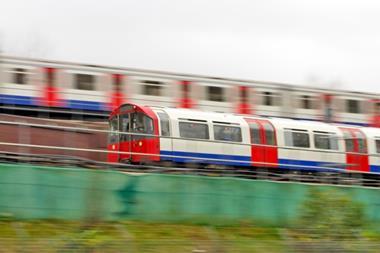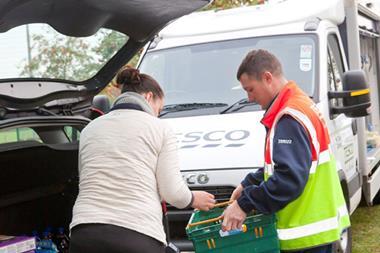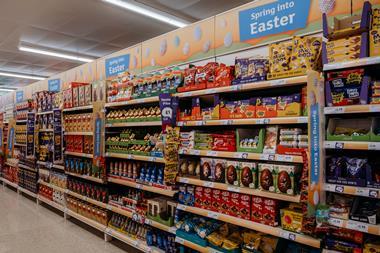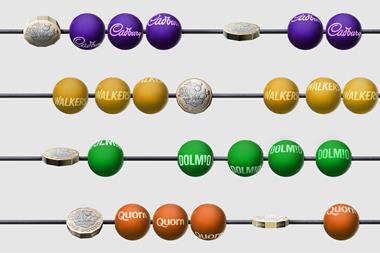For the last couple of years the favourite buzz phrase in retail has been ‘click & collect’. And the big grocers have been as keen as any to embrace it, with Tesco, Sainsbury’s, Asda and Waitrose embracing, evangelising and experimenting in equal measure.
The approach to click & collect has varied wildly: some offer collection in store some have created drive-thru collection points on their estates to fulfil orders and more recently, others have trialled (or announced trials) of click & collect lockers and collection points in public locations where there are high footfall levels, from the school gates to university campuses, from car parks to tube stations.
Regardless of the approach, all anticipate a strong showing from their click & collect offer over the festive period, with research from Mintel showing that 17% of consumers intend to use click & collect services this Christmas. Sainsbury’s, which offers click & collect in 1,000 stores, says that at Christmas click & collect will be used for around 75% of the retailer’s general merchandise orders (versus 50% during the rest of the year). Impressive figures.
But there’s a problem. IGD research published in August showed that just 18% of shoppers who had shopped online in the previous month had used click & collect, representing just 3% of overall grocery shoppers. And even though click & collect is clearly working for Sainsbury’s in general merchandise, it doesn’t offer the service on groceries - and says it doesn’t intend to in the future, either.
” The potential for click & collect is limited as it doesn’t offer the convenience of delivery to the door”
Adam Fulford, Rufus Leonard
So what are the pros and cons of click & collect? Are we really - as some experts suggest - on the cusp of a click & collect revolution? Or will it turn out to be a very small drop in the supply chain ocean?
While click & collect offers the consumer and the retailer new routes to market, Ocado CEO Tim Steiner is not convinced. He could easily offer this option to customers by renting out 200 sq ft of space here and there, he says. But he’s chosen not to for one simple reason.
“Click & collect is delivering no volume,” he says. “If you sit looking at this from outside, it isn’t working. It’s priced the same as delivery. It only makes sense if your life is so erratic you have no idea whether you will ever be in the house but to charge the same as it costs for online delivery means there is otherwise no incentive on the part of the customer to click & collect.”
Sainsbury’s is equally bearish when it comes to groceries. While refusing to comment on the specific reasons - “although we’ve not ruled it out, it is not something we need at the moment,” says a spokesman. “We have plenty of opportunities for growth from our current model and while [click & collect groceries] might work for other retailers, we are comfortable with our approach” - Sainsbury’s appears to be using click & collect to provide customers with a convenient outlet for its predominantly online general merchandise offer, while encouraging customers to visit its stores - and saving a fortune on distribution in that all-important final mile.
Lockers
John Lewis is doing something similarly complementary with its Waitrose stores - indeed, more than 50% of its click & collect orders are picked up from the 219 Waitrose stores currently offering the service. But Waitrose isn’t limiting its click & collect offer to just the stores. It’s one of a number of supermarkets experimenting with lockers, seeing them as a way to reach customers in locations where they don’t currently have a presence.
“You can collect groceries from all of our stores that operate online, but we are trying to make it more convenient and helpful for customers, with more locations,” explains Waitrose director of e-commerce Robin Phillips.
“We have been trialling drive-thru concepts and a really interesting new piece of technology that I am fascinated by - it’s a temperature-controlled collection locker.”
Customers simply order their items online and they’re texted a PIN code. They can then drive up to a bay in front of the lockers, enter their code and the relevant locker door opens allowing them to retrieve their fresh groceries.
“In terms of putting our brand on stilts where our supermarkets aren’t, this is going to be a really interesting development for us,” says Phillips.
Meanwhile, Asda - which already offers click & collect in 560 stores - is looking to expand its network of locations, offering click & collect at universities, business parks, park and ride venues, petrol forecourts and London Underground stations.

“We are finding that customers seem to be collecting from a point on a journey that they regularly take, so adding click & collect lockers makes sense,” says Jon Wragg, multichannel director at Asda. “The locker might be 20 miles from where they live, but if it is convenient within their schedule we must look to tap into that demand.”
The popularity of lockers is their flexibility, continues Wragg, enabling Asda to expand Asda’s geographic coverage without investing in bricks and mortar stores. And it’s making a major play, promising as many as 1,000 new collection points will be introduced by 2018.
Asda is currently weighing up different options for this roll out, says Wragg. “We are looking at working with a number of partners to see if there is a mutual benefit in putting lockers at their sites,” he explains. “You have to move at pace in this or get overtaken.”
In the race to acquire locker space Asda is going head-to-head with the likes of Amazon, which has already forged a partnership with The Co-operative Group to put lockers in its stores - and the online retailer is also believed to be in talks with London Underground to put lockers in the ticket halls of tube stations.
The ability of click & collect to expand a retailer’s reach beyond its current catchment area looks set to be a key driver in its growth over the next few years. And Simon Goodall, chief strategy officer of Lowe Open believes the supply chain will change forever as a result.
” In terms of putting our brand on stilts, this is going to be a really interesting development for us”
Robin Phillips, Waitrose
“Click & collect is still very much in its infancy in the UK, but already 18% of online shoppers have used it,” says Goodall. “With the innovation possibilities we’re beginning to see, such as Asda’s introduction at tube stations and Waitrose’s link with BP and experimentation with GPS alerts, there is no doubt click & collect will be as big as delivery in the next few years. Indeed, as shopper behaviour continues to evolve there will be increasing expectation to be able to shop anywhere and collect anywhere.”
But Adam Fulford, strategy and planning director at creative engagement agency Rufus Leonard strikes a note of caution. “Ultimately I’d say the potential for click & collect to overtake online delivery is limited,” says Fulford. “Whilst it offers an increase in convenience for many retail customers, it doesn’t offer the profound convenience of delivery to the door for key audiences such as mums.”
Convenience is key
While opinion is divided, recent consumer research conducted by retail communication specialists Quail Digital suggests that, for some shoppers at least, click & collect services could play a greater role in the future.
In a survey of consumers earlier this month, 72% said they would prefer to collect a high proportion of the online orders they make rather than waiting for a home delivery, with 44% citing convenience as the reason behind their thinking. A further 20% stated that it would be cheaper to collect their order as a reason for opting for click & collect - presumably because, in the case of small, online orders, click & collect is free.
“The feeling is that click & collect will be used by a proportion of customers currently using home delivery and a proportion of customers moving from in-store to online shopping,” says Tom Downes, CEO of Quail Digital.
The recent IGD survey also provided encouragement for retailers investing in this area, with click & collect more popular among young shoppers and full-time working parents, and regarded by those who took part in the survey as both quicker and cheaper than home delivery. Over a third of online shoppers who had used click & collect in the past month said they would use it more in the future.
However, the key to winning further repeat business from these customers, and converting more shoppers to click & collect, is making the collection process not only cheap but quick and simple too, whether that’s in store or at a locker. This is not as easy as it sounds, but if the mults can get to grips with these challenges and provide consumers with the option to collect their orders in an even greater number of locations, who knows what the future might look like.
Asks Lowe Open’s Goodall: “Given the current advances, I can fully imagine a world where we’re able to choose our groceries on the train home on a mobile app, then get in the car, drive home via the collection point at BP (where we were already planning to stop for petrol) and arrive home with our top up shop - all without leaving the car. And who wouldn’t be happy with that?”
Grocery click & collect strategies

Asda
C&C outlets: 580
Strategy: Asda plans to create 1,000 new collection points by 2018, at locations
including park and ride sites, business parks, universities and London tube station car parks. Many of these locations will ofer a same-day collection service. The retailer is also weighing up establishing a nationwide network of lockers.

Marks & Spencer
C&C outlets: 470
Strategy: M&S was quick to the click & collect party offering customers a wide range of non-food items through its collection service. Although its approach isn’t particularly revolutionary - some stores have click & collect bays whereas at others you have to use collection points in store - the retailer appears to be making it pay.

Morrisons
C&C outlets: 0
Strategy: The phrase ‘click & collect’ was notably absent from the Morrisons presentation on its online plans (see p36) last week. Although a spokesman for the retailer says that “it’s not in our plan for the next year,” he adds that
“with 500 stores, it’s an interesting avenue and we’re keeping it under review”. Watch this space.

Ocado
C&C outlets: 0
Strategy: Although CEO Tim Steiner says Ocado could easily offer click & collect by renting 200 sq ft of space “here, there and everywhere,” he believes click & collect only has a future if retailers offer the service at a discount. Don’t expect to see an Ocado click & collect service any time soon.

Sainsbury’s
C&C outlets: more than 1,000 supermarkets and c-stores
Strategy: Its general merchandise click & collect offer is going great guns at the moment. But the retailer currently has no plans to start offering click & collect groceries, although Sainsbury’s hasn’t completely ruled out the possibility of introducing this service at some stage.

Tesco
C&C outlets: 2,200
Strategy: Tesco has been leading the charge in click & collect groceries. It provides a non-food click & collect service from 2,000 stores and currently has 200 click & collect drive-thrus for groceries. The retailer recently starting trialling click & collect groceries from vans at school gates, park and rides and at car parks in York.

Waitrose
C&C outlets: 168
Strategy: With only 40 John Lewis stores, more than half of all John Lewis’ click & collect items are picked up from 219 Waitrose stores. Waitrose offers grocery click and collect from 168 stores and has big plans for the future. As well as additional stores, it intends to roll out lockers and drive-thrus to establish a presence in areas where it doesn’t operate stores.



















No comments yet